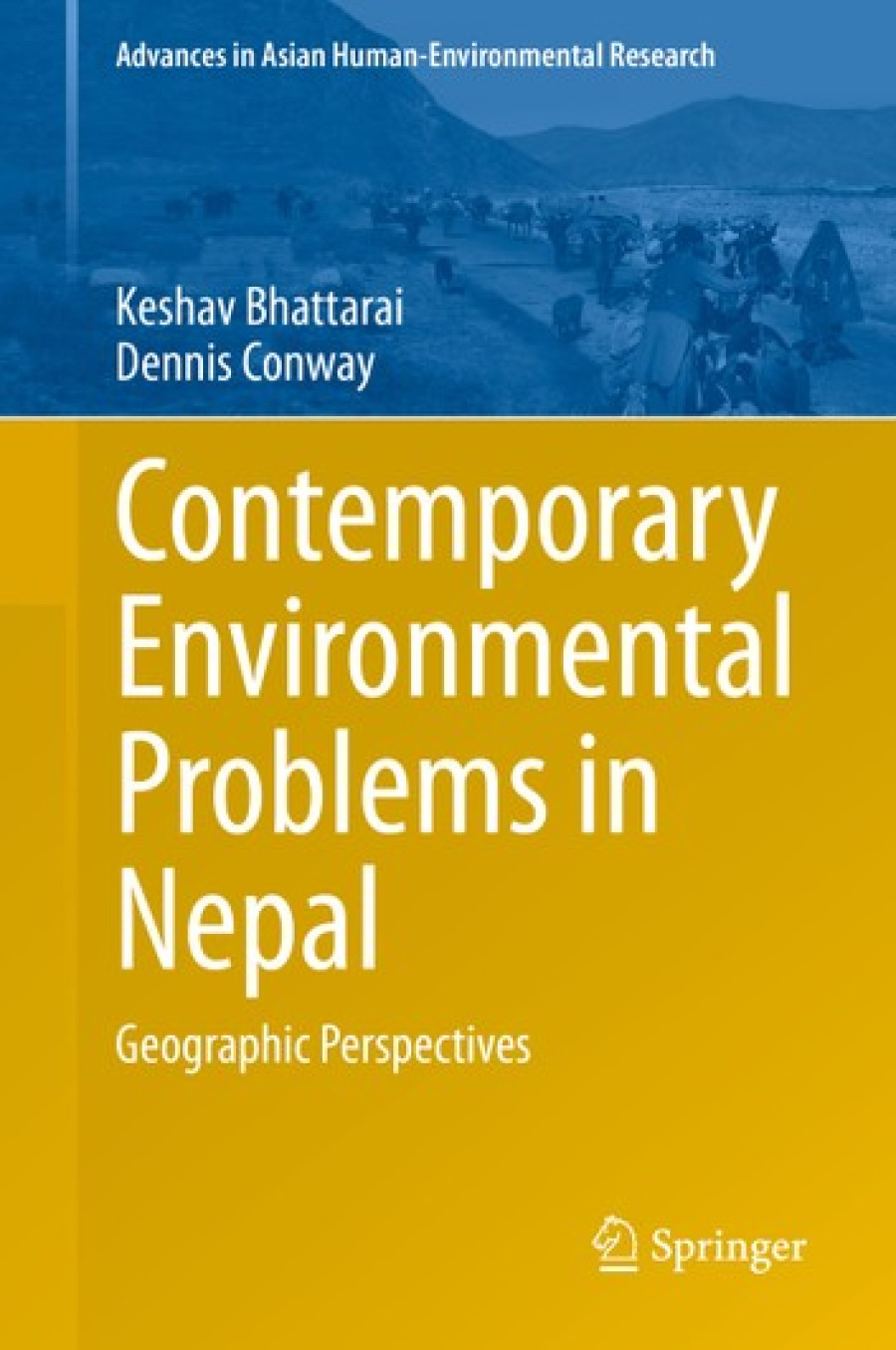Books
Concise development encyclopedia of Nepal
The book Contemporary Environmental Problems in Nepal—Geographic Perspectives brings Nepal’s environmental issues together with geopolitical, demographic and economic conditions.
Prabhu Budhathoki
While the world battles with Covid-19 pandemic, devastating climate-induced disasters are in the offing if the rising global temperature is not contained soon. This means human society may fall from a health pandemic frypan to a fire of climate disaster. Root causes of both the Covid-19 pandemic and growing climate-related disasters have one thing in common–our myopic understanding of economic development and the development pathway we have been pursuing for decades if not centuries. It’s time to rethink!
Development is a multi-dimensional issue. Proper understanding of different facets of development and integrating them appropriately to make good economic policies and development planning is always a daunting task. In other words, finding a right balance between economic, social and environmental issues in development programmes is always challenging in a developing country like Nepal.
Equally hard is finding comprehensive scholarships and literatures which can provide ‘consilience of knowledge’ as articulated by Edward Wilson, a renowned scientist and writer for the harmony of economy and ecology in human actions. More specifically, in the context of developing countries like Nepal, finding comprehensive literature on development and environmental issues is like searching for an oasis.
Prof Keshav Bhattarai, a US-based scholar of Nepali descent, and his colleague Prof Dennis Conway must have realised this knowledge gap when they decided to write ‘Contemporary Environmental Problems in Nepal-Geographic Perspectives’. These two brilliant academicians probably should also have been inspired by Toni Morrison’s bold advice ‘if there is a book that you want to read, but it hasn’t been written yet, you must be the one to write it’.
While the book’s title make it seem like an environmental dossier, in reality, the book is as a concise development encyclopedia of Nepal with interwoven topics on political economy, demography, socio-economy; road, transport and urban planning; water resources and hydropower; agriculture, forestry and tourism; climate change and environment; geography and location specific land use planning. The beauty of this book is that it examines Nepal’s development and environmental issues in the global and South Asian context which helps widen the understanding of environmental issues in this globalised and interconnected world.
With nearly 800 pages with well-connected seven chapters and more than 2,000 useful references, this book nicely presents a comprehensive assessment of Nepal’s environmental challenges from spatial and temporal perspectives which is vital for sustainable development planning. Readers can find brilliant reviews about melting Himal, bleeding mountains and hills, and drying Tarai and Madesh.
The authors claim that this could be the first unique work which brings environmental issues together with geopolitical, demographic, and economic conditions of Nepal after the restructuring of the country. Additionally, the book presents very location specific details to large scale geographical and socio-political perspectives of these issues. One can acquire knowledge of issues from a small hidden hole to horizon scales. The zoomed view reminds us of the Vaidic approach of inquiry to find the true truth—Neti Neti—whereas wide-angle perspectives reflect the Aristotle view ‘the whole is greater than the sum of its parts’.
We can also find many critical observations on the causes of environmental deteriorations and decelerating economic development in the country. Similar to a Swedish saying ‘in a good book the best is between the lines’, readers can find sprinkles of sharp opinions on our political parties, geopolitics, neighbouring countries, aid and international organisations, national economic policies and development planning. By reading this book, one can easily comprehend that the increasing collusion between the existing ‘big brotherly’ attitude of India and China’s aggressive geo-strategic interests will pose a real challenge in the coming days to implement big infrastructure projects in Nepal. Current delays in the implementation of MCC and BRI are its clear indications. Similarly, the book helps readers understand the effects of ‘beggar thy neighbor’ policies of bordering countries in the national economy of a small country. Being a country sandwiched between two big economies, the betterment of Nepal’s economy and environment will largely depend on the cooperation of the two giant neighbours. For the larger and long-term benefits of the region, the current ‘locked’ situation of Nepal should be changed to ‘linked’ situation. This book sheds some light on this issue as well.
Information available in the book will be valuable for policy makers, planners, researchers and students interested to better understand development and environmental issues of Nepal. There’s no doubt holistic understanding is key to address systemic problems the country has been facing for a long time.
One of the main reasons why politicians, policy makers and planners should appreciate this book is because of its honest, critical and comprehensive analysis of Nepal’s development issues as well as suggestions to solve them. The statistics and lucidities presented in the book help us understand why we need to follow a climate-resilient and human welfare-centred environmentally benign development pathway. It articulates the need of proper balance or maintaining reasonable tradeoffs between economic growth, social equity, and environmental health for the sustainable development of a country. The gist of the book is that Nepal should embrace the green economy development model to benefit from its vast forest, beautiful landscapes, and water resources.
Similarly, ecosystem service-based approach is emphasised for the conservation of Churia and for the sustainable flow of ecosystem services to sustain life and livelihood resources in the Tarai. Seven mantras are proposed for the sustainable economic development of Nepal. These mantras can help address the challenge of radically raising people’s living standard while achieving a sustainable footprint. They emphasise the need of location-specific information to develop ‘production model at different agro-climatic conditions’ and ‘monitoring of contemporary environmental issues.’ Geography affects environment and environmental services so geographical knowledge is necessary for better environment planning and management.
Like Swedish economist Gunnar Myrdal says ‘the struggle of long-term economic development in South Asia will be won or lost in agriculture’, the authors also insist on better management of land-based resources and sustainable farming for the economic development and environmental protection of Nepal. However, they warn that climate change and migration of working age populations have been two major threats to sustainable agriculture development in Nepal. It is also revealed that despite an increase in forest coverage in the hills and mountains, the ecosystem services are decreasing due to increasing abandonment of farm lands. There is also concern that we may miss many SDGs and the normal ‘demographic transition’ path without achieving prosperity in the country.
The authors strongly stress the ecologically inseparability of the himal, pahad and Madesh Tarai and advise revision of the current boundaries of the provinces based upon geographic watersheds in order to avoid chaotic situations for water and other resources sharing in the future. Strong relationship between Nepal and our southern neighbor India is also desired to address contemporary environmental issues as two countries are tied with ecosystem services.
The book also draws attention on growing environmental destruction and development victims in different parts of the country due to politically motivated bulldozer engineering practices in the hills and mountains and ecopolitical battle to exploit natural resources in the Churia/Siwaliks and Tarai. Dozer development is becoming an ‘inconvenient truth’ of Nepal’s current development practices.
This monograph seems to have been written in different times; a revised version needs to have data harmonisation. Despite having some weaknesses such as repetitions, data gaps and subjective statements, the book can be a good reference for any person interested in Nepal’s environment and development issues. This book will go a long way in helping society realise ‘ecology is our permanent economy,’ a very powerful slogan by Sunder Lal Bahuguna who started the globally acclaimed chipoko (tree hugging) movement in India’s Garhwal hills. If successful in convincing readers to care for the environment, the book will be a great tribute to all those who devoted and continue to devote their lives for the care of this planet and its inhabitants




 10.12°C Kathmandu
10.12°C Kathmandu











